H Crouch London Antique Brass Wenham Binocular Premier Microscope Sn-1628 1878
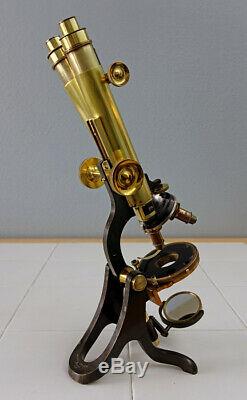

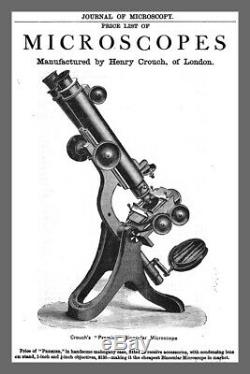
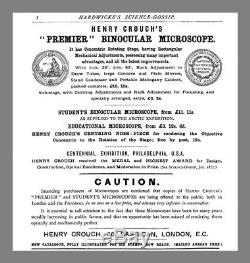
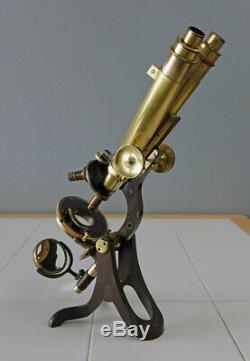
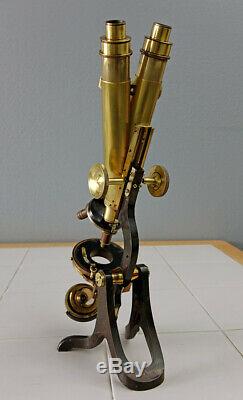
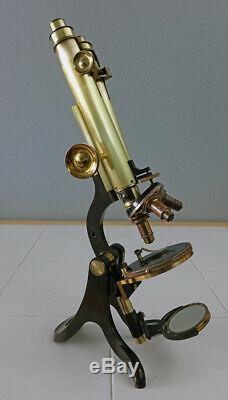
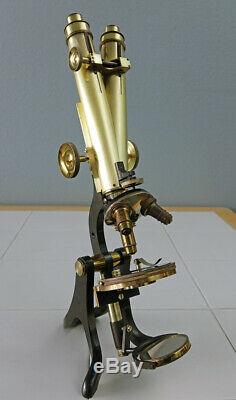
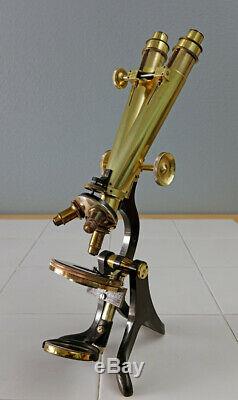
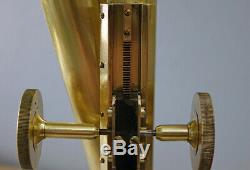

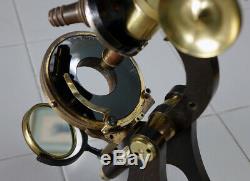

H CROUCH LONDON ANTIQUE BRASS WENHAM BINOCULAR PREMIER MICROSCOPE SN-1628 1878. HENRY CROUCH LONDON ANTIQUE BRASS WENHAM BINOCULAR PREMIER MICROSCOPE, SN-1628, CIRCA 1878.
This microscope is signed in block letters on the top rear of the English-style Crouch foot, HENRY CROUCH, LONDON. It also bears a serial number, 1628, which dates this instrument to circa 1878.
Right from the start of his optical business, Crouch produced several models of his Wenham binocular microscopes, but they all included a flat tripod foot and dual plate pillars that supported the instruments. However, sometime prior to 1876/77, he introduced what has become known as the familiar Crouch foot or the English-style foot to support his microscope models.
It consisted of a looped-shaped rear leg with two forward legs that formed a tripod and provided excellent stability to his instruments. Several other English microscope manufacturers including Swift & Son were soon to imitate and employ this new foot design. NOTE: For more on the history of the Crouch optical firm, please see below. Accompanying this listing is a catalogue illustration of his Premier model Wenham Binocular Microscope that featured this new foot design. This model was featured on the front page of a mini-catalogue of Crouch microscopes that was published in the American Journal of Microscopy in 1877.
Note the exact similarities to the featured microscope. Also included with this listing is a typical advertisement for this same model microscope that was published in Hardwickes Science Gossip Magazine, Volume XIV from 1878. This advertisement drew attention to Crouchs Medal and Award for excellence in microscope design and function received at the 1876 American Centennial Exposition held in Philadelphia, PA, USA.
This antique brass binocular microscope by Henry Crouch will make a fine addition to any antique microscope collection. As the accompanying images will easily attest, this microscope will look great in any display of antique brass binocular microscopes. This microscope is supported on a heavy, sturdy English-style tripod or Crouch foot that has a Japanned black lacquered surface.The foot rises to a wide trunnion joint that supports the Japanned Lister limb, and in turn, the stage and rest of the instrument. The trunnion joint allows the instrument to be inclined at all angles from the vertical to the horizontal. Affixed to the leading edge of the lower limb that is located below the trunnion joint is a 90mm diameter brass stage plate. Mounted atop this plate is a 92mm brass upper stage plate that rotates a full 360 degrees.
It has a black glass insert at the top and features a 40 mm central aperture. A single slide clip is found on top of the stage (Note: One of the slide clips in missing). Mechanically attached to the underside of the lower stage place is a brass sleeve that is able to accept various substage accessories including a rotating disc of apertures or a condenser (Note: No substage accessories are included with this instrument). Also under the stage and attached to the base of the limb is a fixed cylindrical brass bar that holds a moveable 58mm diameter brass mounted plano-concave mirror. The mirror assembly can be moved either closer to or away from the stage by sliding it along the vertical bar. It is also mounted on crank and gimbals allowing it to assume various angles to give either direct or oblique illumination to the stage above. The upper end of the limb supports the Wenham binocular brass body tube of this microscope with its integral horizontal rackwork within a female dovetail assembly.On the front face of the limb is a male dovetail along with a pinion gearbox equipped with a pair of oversize (42 mm diameter) brass milled heads that control the coarse focus. A set of five (5) adjustment screws running vertically at the side of the female dovetail assembly that holds the rackwork to the limb can be used to adjust the tension of the course focus mechanism. Fine focus is by means of a movable internally spring loaded nosepiece found at the base of the binocular tube assembly. The fine focus is controlled by a screw mounted brass milled head that acts on a lever that moves the nosepiece slightly up or down.
This control knob is located on the front face of the body tube. The binocular body tube of the microscope includes a pair of 95mm long drawtubes with lacquered brass ocular holders that are controlled by rack and pinion via a brass milled head found on the right side of the microscope. A matched pair of top-hat style brass oculars (unmarked) is included with this microscope. Note: The slip-over top eyecups are missing from these oculars.
At the lower end of the body tube and enclosed within the movable nosepiece assembly is a removable box slider containing the beam splitting Wenham prism Yes, the original Wenham prism is present in this microscope. Below this is a triple revolving objective holder. A set of three (3) RMS objectives are provided with this instrument. They include a Crouch ¼-inch objective, a Crouch 1/8-inch objective and a Carl Zeiss medium power objective marked with the letter D. Note: The Wenham prism is specifically designed to work with objectives of short focal length typically ½-inch, 1-inch or shorter.Thus, the prism must be removed from the microscope when making microscopic observations with shorter focal length objectives, such as those that come with this instrument. Should one wish to use this microscope for binocular observations this can still be done as the microscope is still fully functional optional suitable short length objectives can be obtained on the used market. On the other hand, if this instrument is to be used for display only in a collection, this will not be an issue, and additional short focal length objectives will not be needed to enjoy this instrument as a collectors item. When the body tube and its dual drawtubes are fully extended and the instrument stands vertically, it stands about 18 inches tall. With the body tube adjusted to its lowest level and its drawtubes retracted and fully nested into the body tube, the microscope stands about 16 inches tall.
The microscope weighs about 13 pounds. There is no wood case or any other accessories included with this microscope. The only exception to this is a mechanical stage that came with the microscope. Some special condition issues related to this part are discussed in the Statement of Condition that follows. NOTE: The attached digital images, captured under ambient light conditions, are a part of this statement of condition. Please take the time to view each of the images so you can confirm the condition of the instrument and so you can see what you will be getting should you prove to be the very fortunate new owner of this Henry Crouch antique brass binocular microscope. In summary, this microscope is in good to very good cosmetic, optical and mechanical condition, but with some specific caveats as noted below. This Crouch microscope came to us in very poor cosmetic condition (See accompanying composite Before and After images). The microscope was covered with a thick layer of dust and grime and most of the lacquered brass parts had a considerable amount of age tarnish present along with some localized pitting of the brass especially on the top and base of the binocular body tube.Thus, we decided to deviate from our customary policy of not deep cleaning antique brass microscopes. In this case, due to the fact that Henry Crouch binocular microscopes are highly prized by collectors, we decided to do a partial restoration of the instrument with a focus on the tarnished body tube. We disassembled the instrument into its component parts and proceeded to remove the dirt and grime with Windex followed by attacking the tarnish with a product known as Pre-Lim. The portions of the body tube containing the pitting to the brass required a more aggressive approach by the use of 1000 and 2000 grit sandpaper in order to remove it entirely.
Wet sanding with Mineral Spirits was used in this case. This was followed by the use of Pre-Lim to restore and polish the brass to its near original condition. We then re-lacquered the brass parts and followed this up by giving the instrument a coating of Renaissance Wax from THE GEMMARY to protect it. The accompanying images of the refurbished instrument attest to the fact that this extra effort at restoration was well worth it. Note: This microscope was originally equipped with a mechanical stage like that shown in the catalogue cut of the instrument from 1877 and in the Before image.
However, we decided to remove it from the refurbished instrument because of some severe defects. The shaft of the x-axis worm was broken off and its control knob was missing and the y-axis brass control knob was missing rendering the mechanical stage inoperable.
Also, the mechanical stage has a considerable amount of tarnish present. An image of the original mechanical stage accompanies this listing. We will include the original mechanical stage with the refurbished microscope so a future owner will have the option of restoring it should he have access to hard to find replacement parts that will be needed to make it fully functional. The optics associated with this microscope (eyepieces and objective lenses) are in very good to excellent condition with no internal optical defects. However, the eye cups for the oculars are missing and the exterior brass of the objectives is partly tarnished. The plano side of the plano-concave mirror is in excellent condition, while the concave side shows some fogging and tarnish at the edges of the reflective surface. However, it provides very good illumination to the stage. The mechanics associated with this instrument are in generally good condition. Both the coarse and fine focus mechanisms work as designed. However, there is one small worn spot in the coarse focus rackwork (a couple of teeth are bent) making the coarse focus operation "jump" in one small area of the coarse focus range. On the other hand, the drawtube focus is perfect. The circular stage rotates freely. With the defective mechanical stage removed from the microscope, the black glass top is exposed and is found in good condition. However, one of the slide clips is missing.BRIEF HISTORY OF HENRY CROUCHS OPTICAL BUSINESS, LONDON. Pierce Henry Crouch (1838 1916) was born in London in the year 1838. Throughout his professional career, Crouch never used his first name, but went simply by Henry Crouch. Henry learned the optical trade as an apprentice with Smith, Beck & Beck, one of Englands most prestigious optical firms at the time. In about the year 1862, Crouch left the Smith, Beck & Beck firm and formed his own optical business.
His younger brother, William Manning Crouch 1840 ca. 1910, joined him in his new venture forming the partnership of W. Their initial shop location was at Regents Canal Dock, Commercial Road, London and their earliest microscopes, which very closely resembled those produced by Smith, Beck & Beck, bear that address.
In time, the Crouch brothers began to diversify their microscope line to concentrate on producing good-quality, less-expensive microscopes for the middle-class microscopist and student. They were particularly admired for bringing out a low-cost very fine Wenham binocular microscope that was budget priced for their target audience. Henry Crouch joined the Royal Microscopical Society (RMS) in 1863 and the Quekett Microscopical Club in 1866, while his younger brother evidently did not become a member of any microscopical society of the day. This may be explained by the fact that Williams training was mainly in engineering and not in optics. The Crouch brothers exhibited twelve (12) microscopes at the 1863 Annual Soiree sponsored by the RMS, suggesting that they had been making several microscope models by that time.
In the autumn of 1864, the Crouch brothers moved to 64A Bishopsgate Street, London as their retail business location, while retaining the Regents Canal Dock location as their manufacturing facility. Henry and William exhibited their instruments and accessories at the 1866 Dublin Exhibition, winning a Prize Medal for Excellence in microscope stands and objectives. They also participated in the 1867 Paris Universal Exposition. On February 27, 1866, the Crouch brothers dissolved their partnership, with Henry Crouch retaining the full rights to the optical business while his brother, William, pursued a career as a civil engineer.
After the dissolution of the partnership, Henrys optical business continued to prosper. His new business address in 1866 was at 54 London Wall.In early 1873, Henry Crouch moved from London Wall to 66 Barbican, London, where the business remained until 1907. The 1870 catalogue from James W.
Queen of Philadelphia included microscopes from Crouch along with those offered by Nachet of Paris, Hartnack, and Zentmayer. Queen had become Crouchs official US retailer. In 1876, Henry Crouch travelled to the USA and exhibited sixteen (16) of his instruments at the 1876 Centennial Exposition that was held in Philadelphia, PA.His microscopes that were exhibited there received considerable praise and admiration from both the scientific community and from the general public. In addition, the Exposition Commission awarded Crouch the Medal and Highest Award for design, construction, optical excellence, and moderation in price for his Premier binocular microscope and his other models.
Partially as a result of his new business connections in the USA, Crouchs microscope business continued to grow and prosper. By the year 1881, it was reported that he employed 20 men and 6 boys as young apprentices. Then, in 1886, Crouch incorporated as Henry Crouch, Ltd.
In the same year that he was incorporated, he introduced a petrological microscope to the geological community. In the year 1892, Crouch opened a second shop at 141 Oxford Street in addition to the 66 Barbican address.
However, typical of many rapidly expanding businesses, Crouch evidently overextended himself and began to suffer stiff competition from other European microscope manufacturers. By the year 1894, Crouch was offering his instruments via new agents including S.
Maw, Son and Thompson (1894 1900) and ultimately via S. Maw, Son and Sons (1900 1907). The names of these agents were then engraved onto his instruments. Henry went to work for the new firm, supervising the manufacture of microscopes and other equipment.During this time, many of Crouchs microscopes that already existed in their inventory were stamped with the new business name and all newly made instruments were stamped on the foot with S. Maw, Son and Sons, but with no mention of Crouch as the maker.
Henry Crouch died March 16, 1916. Note: This history is based in part on excellent information on Crouch published on the Internet by Brian Stevenson of the UK. We will also entertain reasonable offers for this fine instrument.NOTE: WE WARMLY WELCOME INTERNATIONAL BUYERS. BEST OFFERS: Please plan to submit your best offers as early as possible during the listing period. Due to the fact that we review each offer and judge it on its own merits, we may not be immediately available to review offers submitted during last few hours or minutes of the listing period. FREE scheduling, supersized images and templates.
Make your listings stand out with FREE Vendio custom templates! Over 100,000,000 served. Get FREE counters from Vendio today! The item "H CROUCH LONDON ANTIQUE BRASS WENHAM BINOCULAR PREMIER MICROSCOPE SN-1628 1878" is in sale since Friday, March 29, 2019. This item is in the category "Collectibles\Science & Medicine (1930-Now)\Scientific Instruments\Microscopes, Lab Equipment".
The seller is "mtloggera" and is located in Hamilton, Montana. This item can be shipped worldwide.- Serial Number: 1628
- Country of Manufacture: London, England
- Country/Region of Manufacture: United Kingdom
- Manufacturer: Henry Crouch
- Product Type: Microscopes, Lab Equipment
- Antique Brass Microscope: Premier Binocular Micoscope
- Year of Manufacture: Circa 1878

